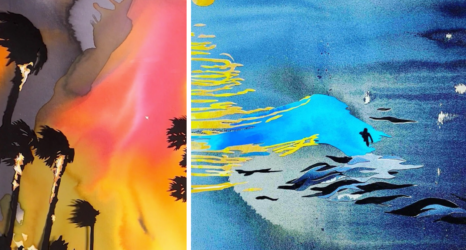Did you catch the Guerrilla Girls on The Late Show with Stephen Colbert? They giggled a lot, but these girls are serious—and have been serious for 30 years—about righting a multitude of wrongs against women artists.
The Guerrilla Girls each have a secret identity named for a woman artist: Frida Kahlo, Romaine Brooks, Georgia O’Keeffe and Emily Carr are all represented, among others. Taking the name of a female creator helps further the Guerrilla Girls’ mission of making women’s work more visible in the art world.
But these smart and feisty gals aren’t the only ones working to bring women’s creative work to light. Art historian and critic Cassandra Langer has written an excellent book, Romaine Brooks: A Life, an in-depth, illustrated biography of one of the great neglected women/lesbian artists.
I interviewed Langer about her book, discussing everything from Brooks’ feminism to her 50-years-long romance.
Ms. Blog: What attracted you to Romaine Brooks?
Cassandra Langer: Her self-confidence and style. She projected such energy and determination that I couldn’t take my eyes away from her self-portrait [from] 1923 in a top hat and incredibly fashionable suit of her own design.
Ms. Blog: Was she a feminist?
CL: No question. She was outspoken, demanded space for herself and other women. She appeared perfectly comfortable with her own body. She and Natalie Barney teamed up in several works that were ostensibly feminist, for example Natalie’s novel One Who Is Legion and Romaine’s “Weeping Venus,” for which Natalie wrote an explicitly feminist poem dealing with the exploitation of women.
Ms. Blog: Which painting of Brooks’ is your favorite, and why?
CL: Oh dear, that’s a hard question to answer, because I admire so many of her paintings and for different reasons. But if push came to shove, I would have to say “The White Bird” and “The Crossing.” The first because it is a summation of her feelings about exploitation of innocence (her own of course). It is, as I point out in the book, not unlike the sculpture, “The Greek Slave” [by H. Powers], which clearly Romaine had in mind when she created “The White Bird.”
“The Crossing” is about depicting lesbian space and her possession of her lover/muse, Ida Rubinstein, who was the Lady Gaga of her era, in the throes of what the French call the aftermath of “small death,” or orgasm. So both these paintings are very powerful feminist social commentary if one knows how to read what Brooks has encoded in them.
Ms. Blog: How has her artistic reputation changed over time, and what is it currently?
CL: Romaine’s reputation mirrors the stock market: it’s up/down/up. She was famous from roughly the first decades of the 20th century through the 1930s. She lost ground during the war because she spent it in Italy with Natalie Barney and had to do a lot of side-stepping to avoid being carted off to the camps by the Fascists. And because, like most upper-class Americans at this time, [she] was a bigot when it came to Jews. She was an elitist, so she was very selective in her discrimination; for example, having Ida Rubinstein, who was a white Russian Jew, as a lover and Natalie Barney, who was a quarter Jewish. Living with Natalie in Italy under Fascists and Nazis proved a daunting challenge for Romaine. I go into this in detail in my book.
Ms. Blog: How would you compare her work with other art by lesbians?
CL: Given the period of emerging Modernisms we are dealing with, I would have to say she was at the top of the pantheon. Gluck is second-rate by comparison. Even today within the genre she chose, she is superior and fully deserving of a retrospective view in the context of her peers. Currently there is a solo showing of her work in Venice at the Fortuny Museum, and there will be a showing of her work at the Smithsonian American Art Museum opening June 17 in Washington, D.C.
Ms. Blog: How does your biography differ from other biographies of Brooks?
CL: I had the advantage of discovering Romaine Brooks’ long-kept secret: The fact that she was involved in a long-term polyamorous relationship dating from 1916 (other biographers got the date wrong as 1915), which is supported by a letter that Lily de Gramont wrote to Natalie Barney that has only come to light in the last couple of years. So I was able to establish a number of facts about Romaine and her life that refuted much of what had been written about her gloomy depressive nature. Most of what has been written about that is untrue, along with accusations that she was anti-Semitic. There is a difference between a bigot and a person who is willing to consign people to death in a concentration camp. It would never have entered her mind, she was not a fascist sympathizer, and in fact she and Natalie Barney saved at least three Jewish lives at risk of their own safety and helped to hide Bernard Berenson’s whereabouts during the war.
Ms. Blog: What is the most surprising thing you learned about Brooks during your research?
CL: Her capacity for love and connection. Given all that had been written about her, I never expected to uncover her deeply felt ability to love anyone. Her love for Natalie was unshakable right up until the end of her life. Other biographers do not agree with me, but they did not have access to the resources I discovered. Given her stoicism, her pride and considering both her and Natalie’s distain for neediness, I looked for an explanation as to why Romaine cut off communications with Natalie. I came to the conclusion, based on evidence, that they both saw neediness as a kind of vampirism—a weakness, if you will, of character. So I was not surprised that Romaine, who was failing, cut off relations with the woman she had been in love with for over 50 years. I go into this in my book as well. I leave it up to my readers to determine the viability of my conclusion.
Get Ms. in your inbox! Click here to sign up for the Ms. magazine newsletter.
Portrait of Romaine Brooks via Wikimedia Commons
Mary Meriam advocates for the right of women to love each other in their poetry and art, and strives to give their work a place at the table. She writes about and publishes such work in the journal she founded, Lavender Review, at the press she cofounded, Headmistress Press, and at Ms. magazine, The Critical Flame and The Gay & Lesbian Review. Her poetry collections, The Countess of Flatbroke, The Poet’s Zodiac, The Lillian Trilogy and Lady of the Moon, honor a cosmos of strong, creative women.





